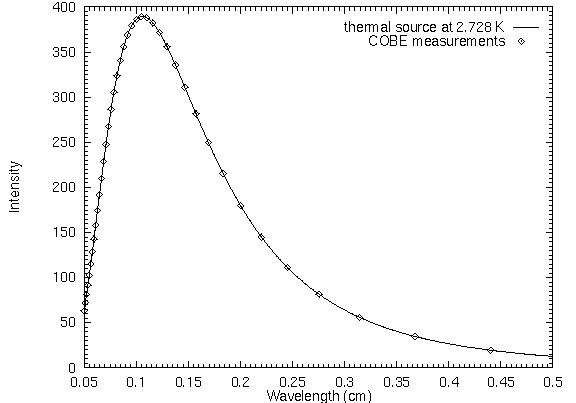
This material (and images) is copyrighted!. See my copyright notice for fair use practices.
George Gamov (lived 1904--1968) predicted in 1948 that there should be a faint glow left over from when the universe was much hotter and denser. Since the universe is observed to be expanding, it means that the galaxies were originally right on top of each other. Also, the energy of the universe was concentrated in a smaller volume. The entire universe would have glowed first in the gamma ray band, then the X-ray band, then to less energetic bands as the universe expanded. By now, 15 billion years after the start of the expansion, the cold universe should glow in the radio band. The expansion rate has slowed down over time because of the force of gravity. This means that the early expansion was faster than it is now. At the start of the expansion, the expansion rate was extremely rapid.
The early large expansion rate and very hot temperatures made Fred Hoyle call this theory of the birth of the universe, the Big Bang. At the time he coined the term, Hoyle was advocating another theory that used the perfect cosmological principle called the Steady State theory. So at the time, Hoyle's ``Big Bang'' term was made in joking disdain. However, the Big Bang proponents liked the term and used it from then on.

Let's take a closer look at what was happening in the universe when it produced the background radiation. The early universe (both the matter and the radiation) was much more compact. The radiation density was so great that it dominated the expansion rate and the conditions of the universe for the first 10,000 years. Remember Einstein's equation relating energy and mass? The energy E=mc2 so the radiation energy had a definite gravitational effect!
The early universe was hot and opaque (photons could not move very far before being absorbed). The freely-moving electrons, protons, and neutrons scattered the photons all about making the dense gas opaque. Dense hot gases will produce a continuous spectrum that depends only on the temperature (a thermal spectrum). The universe cooled off as it expanded. Eventually, the early universe cooled to where the electrons and protons could combine to form neutral hydrogen atoms and not be blown apart by energetic photons. The process of the electrons becoming bound to the protons to make atoms is called recombination. Okay, ``recombination'' is not really correct since this was the first time that the electrons combined with the protons, but it also describes processes that occur today.
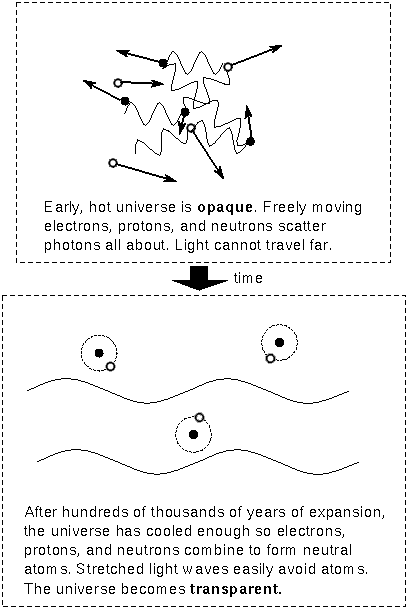
At the time of recombination, the number of unit particles was cut at least in half (one electron + one proton become a single atom; the neutrons also were incorporated into the atoms). That meant the photons could travel further without hitting some kind of unit particle. Also, the expansion of the universe spread the matter out. In addition, the coolness of the universe (only 3000 K at the time of recombination) meant that longer wavelengths of light were present. Instead of the gamma rays and X-rays of earlier times, the predominant form of radiation was the longer wavelength visible light and infrared. Longer wavelengths of light are able to more easily to pass through gas. For all of these reasons the photons could then travel long distances without running into some particle. The universe became transparent when the universe was glowing at the temperature of the surface of a cool star.
Extrapolating the expansion rate and the temperature of the universe backward in time, one finds that at the temperature of 3000 K, the universe was a few hundred thousand years old. The photons from this time are now reaching our radio telescopes. They are by far the oldest radiation that can be detected.
The universe could not have been perfectly uniform, though. The universe must have been slightly lumpy to form galaxies and people later on from the internal gravity of the lumps. Gravity is symmetrical so it needed some initial density variations to provide some direction to where surrounding matter could be attracted. The COBE satellite found slight variations in the brightness of the background radiation of about 1 part in 100,000. The slight variations exist because some parts of the universe were slightly denser than other parts. The slightly denser regions had more gravity and attracted more material to them while the expansion occurred. Over time, the denser regions got even denser and eventually formed galaxies about 1 billion years after the Big Bang.
Below is a sequence of false-color microwave all-sky maps from the Differential Microwave Radiometer (DMR) instrument on the COBE satellite. The galactic equator runs horizontally through the center of each map. The range of temperatures for each map is given in the caption.
 The colors for the temperatures range from blue for 0 K to red for 4 K (yes, the color scheme is backward---blue should be hot and red should be cool). Notice that the background appears completely uniform at a temperature of 2.728 K. |
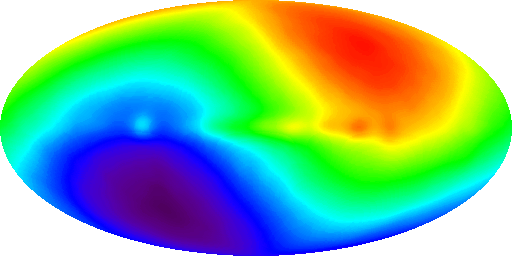 The colors for the temperatures range from blue for 2.724 K to red for 2.732 K. The double-lobe pattern shows the doppler effect from the motion of the Sun with respect to the background radiation. The background appears about 1/1000 times hotter (redder in this false-color map) in the direction the Sun is moving toward and about 1/1000 times cooler (bluer here) in the direction the Sun is moving away from. |
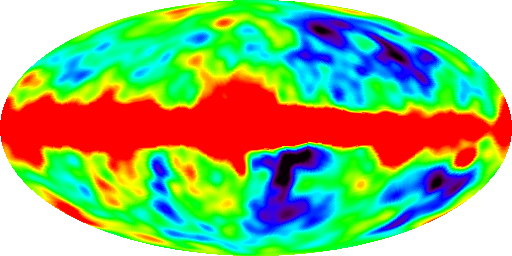 The colors for the temperatures range from blue for 2.7279 K to red for 2.7281 K. The effect of the Sun's motion has been subtracted out leaving fluctuations that are thirty times smaller than the previous map. The faint microwave contribution of the Milky Way is clearly seen along the center. The Cygnus constellation is at left center, the Sagittarius constellation is at the center, and the Orion constellation is at right center. |
Below is a picture of the fluctuations in the background radiation when the Milky Way's contribution is subtracted out. The view is now looking up above the galactic plane and looking down below the galactic plane. The largest superclusters such as the ``Great Wall'' seen in Geller and Huchra's slice map of our local part of the universe would easily fit inside the smallest feature on this map. Selecting the map will take you to more DMR images from the COBE mission.
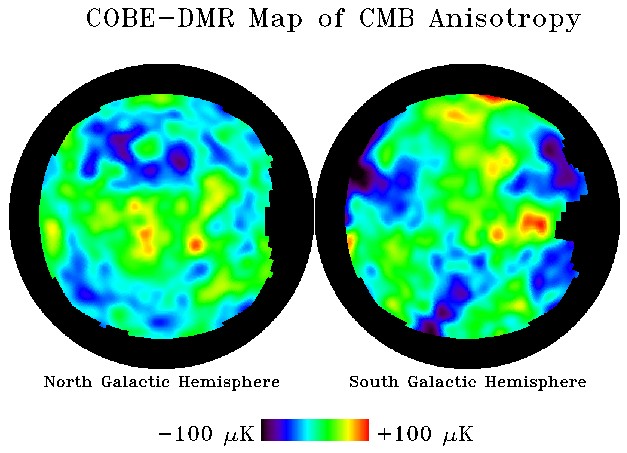
The antimatter counterpart of an ordinary particle has the same mass and opposite charge of the ordinary particle (if it is not neutral). When an ordinary particle and its antimatter counterpart collide, they completely annihilate each other to create photons. The process can be reversed if the photons have enough energy (i.e., are high-energy gamma ray photons). Within the first microsecond (10-6 second), the universe was hot enough for the photon radiation to undergo this matter-antimatter particle transformation using massive particles like protons and neutrons. When the temperature dropped to about 1013 K at one microsecond after the Big Bang, this process stopped for the protons but it continued for the less massive particles like the electrons. Neutrons were not created in the energy-matter conversion process but some were created when protons and electrons fused together.
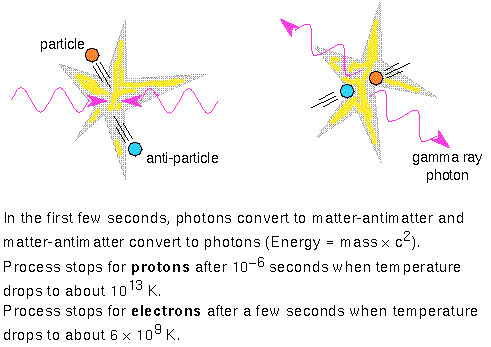
When the universe had expanded for another few seconds, it cooled to a temperature of ``only'' 6 × 109 K and the electron-positron production and annihilation process ceased. This is also the time when the number of neutrons stopped increasing from the proton-electron fusion process. The number of neutrons was fixed at a ratio of 1 neutron for every 5 protons. For reasons not completely understood, there was a very slight excess of ordinary matter over antimatter (by about 1 part in 109). This is why there was still some ordinary matter left over when all the antimatter had been annihilated. (This must be the case, otherwise you wouldn't be here!) All of the protons, neutrons, and electrons in matter today were created in the first few seconds after the Big Bang.
The deuterium nucleus is the weak link of the chain process, so the fusion chain reactions could not take place until the universe had cooled enough. The exact temperature depends sensitively on the density of the protons and neutrons at that time. Extremely small amounts of Lithium-7 were also produced during the early universe nucleosynthesis process. After about 15 minutes from the Big Bang, the universe had expanded and cooled so much that fusion was no longer possible. The composition of the universe was 10% helium and 90% hydrogen (or if you use the proportions by mass, then the proportions are 25% helium and 75% hydrogen).
Except for the extremely small amounts of the Lithium-7 produced in the early universe, the elements heavier than helium were produced in the cores of stars. Stars do produce some of the helium visible today, but not most of it. If all the helium present today was from stars, then the nuclear reaction rates would have to be extremely high and the galaxies should be much brighter than they are.
The deuterium nucleus is a nucleus of special importance because of the sensitivity of its production to the density of the protons and neutrons and temperature in the early universe. The number of deuterium nuclei that do not later undergo fusion reaction to make Helium-3 nuclei also depends sensitively on the temperature and density of the protons and neutrons. A denser universe would have had more deuterium fused to form helium. A less dense universe would have had more deuterium remaining. The amount of the final Helium-4 product is not as sensitive to the density of the early universe, so the amount of the remaining deuterium seen today is used as a probe of the early density. Measurement of the primordial deuterium then can show if there is enough matter to make the universe positively-curved and eventually stop the expansion.
| Big Bang | cosmic microwave background radiation | deuterium |
|---|---|---|
| recombination |
![]() Back to introduction and universe curvature sections
Back to introduction and universe curvature sections
![]() Go to
fate of the universe section
Go to
fate of the universe section
last update: 05 April 1999